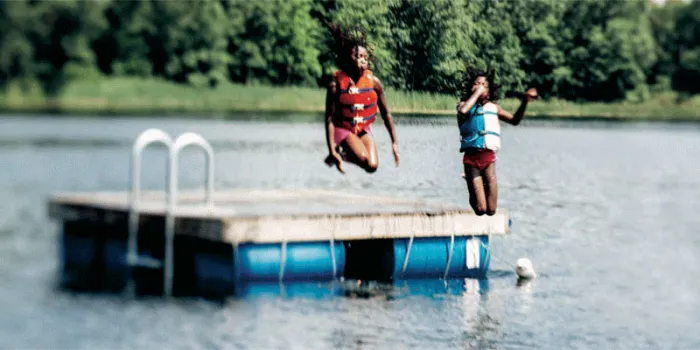Ding-dong! Ding-dong! The sound of a ringing bell means another camper has reached the top of the climbing tower at Camp Wannaklot—a weeklong summer camp in the Georgia woods for kids and teens with bleeding disorders. “Everyone near the tower cheers,” says Kim Williams, director of camp and client events at Hemophilia of Georgia (HOG). “It’s a big moment—the kids are so excited about their accomplishment. It can take a lot of courage to reach the top.”
A ringing sound you won’t hear is a cellphone. At Camp Wannaklot—and at the more than 50 overnight summer camps in 37 states for young people with bleeding disorders—phones, music players, video games and other personal electronics are, for the most part, forbidden. “We want campers to connect with each other and with the natural world—to really make friends and to challenge and enjoy themselves,” Williams says. “Bleeding disorders are relatively rare. This may be the first time a camper is meeting other kids with similar conditions. It’s a chance to make friends for life.”
Banning or limiting personal electronics is an issue for all summer camps—so much so that most of the nation’s nearly 8,400 camps forbid or limit their use, according to the American Camp Association. There are exceptions. Williams notes that at Wannaklot, kids and teens who use phone apps to track medications and other health data leave their devices at the medical lodge. Staffed by specialist physicians and nurses from HOG and from Georgia’s hemophilia treatment centers, the lodge is where campers can get medical attention, infuse or update their health apps.
Otherwise, tech-free is the golden rule. Without a device occupying a camper’s fingers, eyes and attention, they can immerse themselves in the fun, freedom and friendships unfolding around them. Camps for kids with bleeding disorders offer a wide range of classic summer fun—from campfires and canoeing to archery, fishing, hiking, swimming, silly songs and more. Kids learn to take a bigger role in managing their own health, too. “This is where some kids learn to self-infuse for the first time,” Williams says. “They learn about their condition, their medications and their equipment. Their care and health are carefully monitored and we adjust activities so they stay safe, creating an environment where they can grow.”
Disconnecting has other benefits, says Laurel Pennick, LCSW, MSSW, BA, a clinical social worker at the Arizona Hemophilia and Thrombosis Center: “I’ve heard parents say, ‘My kid came back from camp and he was so mellow.’ He had no media for a week. They have a sense of community. They’re looking people in the face. They reacquaint themselves with looking at body language and they can see if they hurt somebody or if somebody’s suffering. You don’t get that in a text, no matter how many emojis you use.”
It also fosters physical activity. “The physical rough and tumble of camp is important,” Pennick says. “We have a lot of kids who spend a lot of time on the couch, playing video games. At camp, we’re getting kids out there being active. Maybe they’ll like it and do it when they go home!”
Find summer camps for kids with bleeding disorders near you by contacting your local chapter or hemophilia treatment center, or use NHF’s online camp locator.

